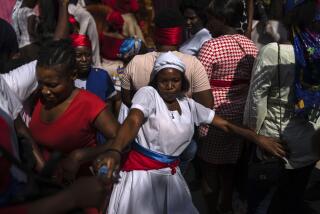Cruise-Ship Stop That Dares Not Speak Its Name
- Share via
LABADIE, Haiti — The turquoise bay ringed by the ruins of a 19th-century plantation and crimson-flowered flamboyant trees is everything the tourist brochures promise -- tranquil waters, pristine beaches, good food, exotic local culture.
But few tourists realize that they’ve taken a cruise to Haiti, the Western Hemisphere’s poorest nation.
“Can you see Haiti from here?” asked Linda Tracy, 59, of Camden, Maine, disembarking from the cruise ship Explorer of the Seas with 3,400 other passengers who scurry toward banana boats, Jet Skis and art stalls.
Since 1986, Royal Caribbean has provided the largest source of tourism revenue to Haiti, sometimes bringing more than 7,000 tourists a week. Each passenger pays a $6 tax to the government, which comes to more than $2 million a year, and more than 200 or so Haitians are paid to attend to them as bartenders, musicians and cabana boys.
The jobs are a blessing in a country where political instability has stunted growth, leaving two-thirds of workers without jobs. But some people say more knowledge of Haiti and its problems might bring more help.
“In America, we’ve taken opportunities for granted,” said tourist Ron Winslow, a customer service representative from Akron, Ohio. “Here, people would love to have opportunities, but we hardly hear anything about their country.”
Winslow said he had to research his travel itinerary to realize that he was going to Haiti.
Some passengers were told only that they were headed to Hispaniola, the island shared by Haiti and the Dominican Republic. Most said they were told that they were going to a private beach off the coast of Haiti.
Royal Caribbean’s Web site refers to the bay as “Labadee, Hispaniola.” Another section calls the beach, on Haiti’s north coast, a “private island.”
“This is merely an effort to be inclusive and refer to the entire island of Hispaniola, which is geographically correct,” said Michael Sheehan, a company spokesman.
He described the cruise as a win-win situation: “Our guests get to experience the unique nature of the given destination -- and the destinations experience a positive economic impact.”
The company leases Labadie Beach from Societee Labadie Nord SA, which puts on the entertainment. It also provides rifle-toting guards on days that there are no cruise ships, usually Wednesday through Sunday, when they admit Haitian tourists who can afford it.
“On cruise ship days, this place is very different,” said Jean-Arrol Santel, 32, a beach supervisor who earns about $400 a month. “Hopefully, even more people will come and there will be more jobs. It’s important for Haiti.”
Maryse Penette-Kedar, president of Societee Labadie, which is known by the acronym Solano, said more jobs could be created if the brisk business continues. She also said that if conditions improve, tourists might start going farther afield, such as to the Citadelle fortress or Sans Souci castle.
“I think it’s improved the country’s image abroad and helped Haitians,” she said. “Solano is the No. 1 employer in the north, with more than $1 million of payroll a year.”
On Mondays and Tuesdays, cruise ships sail into the harbor and small boats ferry thousands of people across the bay. They flock to hear Haitian musicians, sip pina coladas, and snack on hot dogs and hamburgers from the ship. Some jump on inflatable jungle gyms in the water, then run back to the beach to collapse on lounge chairs.
The excursions last about seven hours. Then they’re off to their next Caribbean stop.
Musician Felix Valcourt, 75, wishes that the tourists would do more.
“If each one of them dropped a quarter in a bin during their visits, it would help build a high school or a clinic,” said Valcourt, dressed in a tropical shirt stiff from pressing. In two weeks, he and his band of four earn $200.
He complains that the tourists rarely tip and says none has ever ventured across the bay to Labadie Village or shown much interest in Haiti. “No one ever asks us any questions about our lives, and the ships keep coming without bringing us any kind of real rewards,” he said.
For those locked outside Labadie’s gates, the rewards are even slimmer. Many craft vendors stand outside, hoping the stall operators will buy their cha-cha rattles and paintings that sell at a 30% profit inside. Other people rummage through garbage in search of leftover food.
Still, Tracy, the visitor from Maine, said the stopover had made her think about the broader Haitian culture.
“This has been a humbling and educational experience,” she said. “Voodoo, witchcraft and poverty -- that’s all I knew.”
More to Read
Sign up for The Wild
We’ll help you find the best places to hike, bike and run, as well as the perfect silent spots for meditation and yoga.
You may occasionally receive promotional content from the Los Angeles Times.






